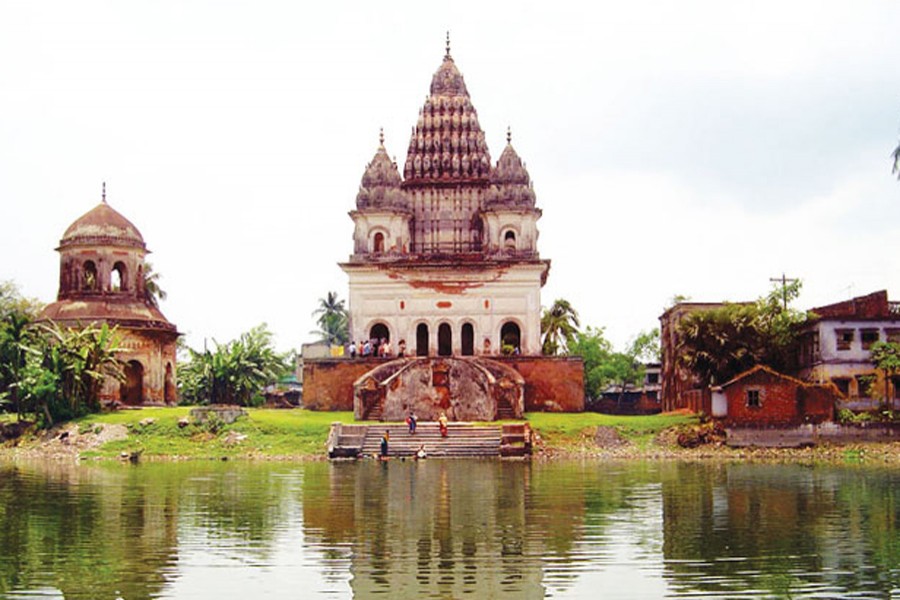RAJSHAHI, Nov 01: Tourists are attracted when they visit temple complex at a local "estate" at Puthia, some 23 kilometres to the east of Rajshahi city.
But the cluster of centuries-old Hindu temples in Puthia upazila town is under threat for lack of conservation efforts as well as from unplanned constructions nearby.
Sources said, the Mughals was created Puthia Zamindari, one of the oldest estates of Bengal, in the early 17th century.
A large number of temples were set up here. The temples were built by Hindu Zamindars of the Puthia Raj family who were noted philanthropists of Rajshahi. Some 17 large and small temples still exist at Puthia now.
The two-storied main Puthia Rajbari, which is the most notable structure in the area, faces a four-storied large pyramid-type "Dol-Mancha" on the north, across an open ground and has an imposing 60.96 metre facade.
It has two symmetrical projected wings at the east and west ends while its central part, about 15.24 metre wide, accommodates a grand portal.
Earlier, Zamindar Nilambar received the title of Raja from then Emperor Jahangir (1605-1627). The estate was split in 1744 when the eldest son received a 51/2-anna share while the three others received 31/2-anna share.
The Puthia Raj estate existed till the abolition of the zamindari system under the then East Pakistan Estate Acquisition Act of 1950.
The Pancharatna Govinda Temple is a beautiful little "do-chala" shrine behind the palace. The hut-shaped Jagaddhatri Temple is on the west and the large Shiva Temple at the entrance of the estate.
A 3.05m wide verandah runs along the front and provides access to the large halls behind. The balcony roof is supported on three graceful semi-Corinthian fluted columns, rising up to the upper floor.
The central bay is relieved with a triangular pediment and the parapet decorated with delicate floral plaster relief. The broad verandahs of the terminal bays on the east and the west are carried on four lofty fluted Corinthian columns, similarly shooting up to the upper floor ceiling.
The extensive area of the estate, enclosed within a moat, has a number of elegant temples embellished with terracotta sculpture.
In 1823, the Shiva Linga Temple, about 19.81 square metre building, was erected by Rani Bhuvan Mohini Devi on a high plinth and plastered all over.
It's decorated with numerous miniature "ratnas" on the main tower and on the four smaller towers on the roof of the ground floor.
This ornate temple is an imposing and excellent example of the five-spire style (Pancha Ratna) temple architecture common in northern India. The corridors have a touch of Jaipuri architecture and in the sanctuary lies a large black basalt "Shiva Linga," the largest in the country.
During the liberation war in 1971, Pakistani army attempted to destroy the "Shiva Linga," but was unable to move it.
Rajbari sources said the temples have been built in terracotta in a variety of styles combining the typical "Jor-bangla" architecture with other influences.
Besides the palace of the Raja of Puthia and the "Dol Mancha" is part of the complex and the temples are laid out around a lake with a sprawling lawn.
This grand temple of Puthia, the Govinda Temple was erected in mid-nineteenth century by the queen of Puthia. The temple is dedicated to Lord Krishna, as the Puthia royal family was converted to Vaishnavism by Radhamohan Thakur.
The temple has exquisite terracotta ornamentation depicting the divine romance between Krishna and Radha.
The temple's survival is threatened by the newly established college nearby and the lack of conservation efforts.
The buildings and temples have lasted for a little over 100 years, but questions have been raised whether it will last another century.
Hemanta Kumari Devi, who ordered its construction would probably be glad of its present use, but would have been saddened by its state. To one side, and a little behind, stands the nearly 200-year-old Govinda Temple.
But whilst Kantaji, perhaps, may boast even finer terracotta friezes, Govinda Temple has retained the spires that the earthquake brought down at Kantaji.
The Jagannath Temple, Gopala Temple, and an array of lesser shrines and outbuildings make travelling around the area around well worth the time spent at the temple, which remains, even in today's traffic, just about a day trip out of Dhaka.


